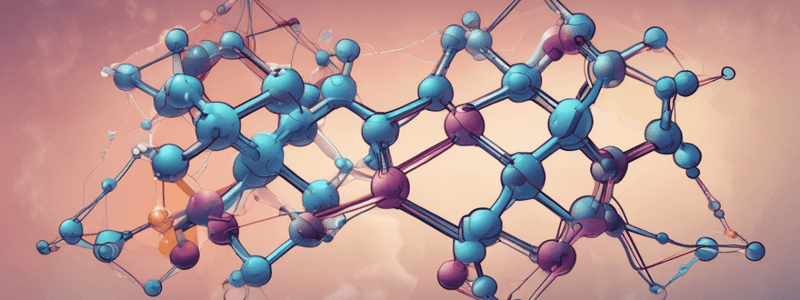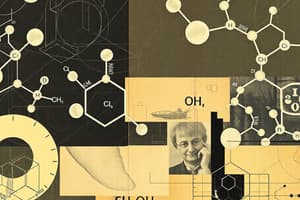Podcast
Questions and Answers
What is the first step in drawing the dot structure for a molecule?
What is the first step in drawing the dot structure for a molecule?
- Identify the group number of the elements
- Find the total number of valence electrons (correct)
- Determine the number of covalent bonds
- Determine the number of energy levels
What does the group number of an element correspond to?
What does the group number of an element correspond to?
- The number of energy levels
- The number of periods
- The number of covalent bonds
- The number of valence electrons (correct)
What is the maximum number of electrons that can be fit in the first energy level?
What is the maximum number of electrons that can be fit in the first energy level?
- 6
- 4
- 2 (correct)
- 8
What is the significance of the octet rule in drawing dot structures?
What is the significance of the octet rule in drawing dot structures?
What is true about the second period of the periodic table?
What is true about the second period of the periodic table?
How many valence electrons does hydrogen have?
How many valence electrons does hydrogen have?
What is the relationship between periods and energy levels in the periodic table?
What is the relationship between periods and energy levels in the periodic table?
What is the purpose of using a modified periodic table when drawing dot structures?
What is the purpose of using a modified periodic table when drawing dot structures?
What is the purpose of understanding the octet rule in drawing dot structures?
What is the purpose of understanding the octet rule in drawing dot structures?
Why is it possible for elements in the third period to exceed the octet rule?
Why is it possible for elements in the third period to exceed the octet rule?
How many valence electrons does a single atom of silicon have?
How many valence electrons does a single atom of silicon have?
What is the total number of valence electrons in the molecule silicon tetrafluoride?
What is the total number of valence electrons in the molecule silicon tetrafluoride?
Why is silicon chosen as the central atom in the dot structure of silicon tetrafluoride?
Why is silicon chosen as the central atom in the dot structure of silicon tetrafluoride?
How many covalent bonds are drawn in the initial dot structure of silicon tetrafluoride?
How many covalent bonds are drawn in the initial dot structure of silicon tetrafluoride?
How many valence electrons are represented in the initial dot structure of silicon tetrafluoride?
How many valence electrons are represented in the initial dot structure of silicon tetrafluoride?
What is the main goal of step three in drawing dot structures?
What is the main goal of step three in drawing dot structures?
Why do fluorine atoms need to be surrounded by eight electrons?
Why do fluorine atoms need to be surrounded by eight electrons?
What is the valence electron count for oxygen in the periodic table?
What is the valence electron count for oxygen in the periodic table?
What is the central atom in the molecular formula CH2O?
What is the central atom in the molecular formula CH2O?
How many valence electrons are needed to represent in the dot structure of CH2O?
How many valence electrons are needed to represent in the dot structure of CH2O?
What is the purpose of step four in drawing the dot structure?
What is the purpose of step four in drawing the dot structure?
Why are hydrogen atoms not considered when deciding the central atom?
Why are hydrogen atoms not considered when deciding the central atom?
How many valence electrons are left over after assigning electrons to the carbon and hydrogens in CH2O?
How many valence electrons are left over after assigning electrons to the carbon and hydrogens in CH2O?
What is the trend for electronegativity in the periodic table?
What is the trend for electronegativity in the periodic table?
What is the purpose of step three in drawing the dot structure?
What is the purpose of step three in drawing the dot structure?
What is the valence electron count for carbon in the periodic table?
What is the valence electron count for carbon in the periodic table?
How many valence electrons are assigned to each fluorine atom in the dot structure?
How many valence electrons are assigned to each fluorine atom in the dot structure?
What do you do with leftover electrons after step three in drawing a dot structure?
What do you do with leftover electrons after step three in drawing a dot structure?
What happens if the central atom has an octet or exceeds an octet after assigning leftover electrons?
What happens if the central atom has an octet or exceeds an octet after assigning leftover electrons?
Why do you not need to worry about formal charges in this example?
Why do you not need to worry about formal charges in this example?
What is the typical way to represent the dot structure of xenon pentafluoride cation?
What is the typical way to represent the dot structure of xenon pentafluoride cation?
What is the purpose of drawing dot structures?
What is the purpose of drawing dot structures?
What is the total number of valence electrons in the xenon pentafluoride cation?
What is the total number of valence electrons in the xenon pentafluoride cation?
What is the correct dot structure for formaldehyde?
What is the correct dot structure for formaldehyde?
What type of electrons are involved in bonding between atoms?
What type of electrons are involved in bonding between atoms?
How many valence electrons does xenon have?
How many valence electrons does xenon have?
Why does the xenon pentafluoride cation have a positive charge?
Why does the xenon pentafluoride cation have a positive charge?
What is the total number of valence electrons in the xenon pentafluoride cation?
What is the total number of valence electrons in the xenon pentafluoride cation?
What is the central atom in the xenon pentafluoride cation?
What is the central atom in the xenon pentafluoride cation?
How many valence electrons are represented by the bonds in the xenon pentafluoride cation?
How many valence electrons are represented by the bonds in the xenon pentafluoride cation?
Why can xenon exceed the octet rule in the xenon pentafluoride cation?
Why can xenon exceed the octet rule in the xenon pentafluoride cation?
How many valence electrons are left over after representing the bonds in the xenon pentafluoride cation?
How many valence electrons are left over after representing the bonds in the xenon pentafluoride cation?
How many valence electrons are assigned to each fluorine atom in the xenon pentafluoride cation?
How many valence electrons are assigned to each fluorine atom in the xenon pentafluoride cation?
Flashcards are hidden until you start studying
Study Notes
Drawing Dot Structures
- Step 1: Find the total number of valence electrons
- Look at the periodic table to find the number of valence electrons for each atom in the molecule
- Group number corresponds to the number of valence electrons
- Periods (energy levels) determine the maximum number of electrons that can be held
- The octet rule: elements in the second period (energy level) can have a maximum of 8 electrons
- Step 2: Decide on the central atom
- Choose the least electronegative element in the molecule
- Ignore hydrogen when deciding on the central atom
- Refer to the periodic table to determine the relative electronegativities of the elements
Silicon Tetrafluoride Example
- Step 1: Find the total number of valence electrons
- Silicon has 4 valence electrons (group 4)
- Fluorine has 7 valence electrons (group 7)
- Total valence electrons: 4 (Si) + 28 (4F) = 32
- Step 2: Decide on the central atom
- Silicon is the least electronegative element, so it's the central atom
- Step 3: Assign leftover electrons to terminal atoms
- Each fluorine needs 8 electrons to follow the octet rule
- Assign 6 electrons to each fluorine, totaling 24 electrons
- Remaining electrons: 32 - 8 = 24
Formaldehyde Example (CH2O)
- Step 1: Find the total number of valence electrons
- Carbon has 4 valence electrons (group 4)
- Hydrogen has 1 valence electron (group 1)
- Oxygen has 6 valence electrons (group 6)
- Total valence electrons: 4 (C) + 2 (2H) + 6 (O) = 12
- Step 2: Decide on the central atom
- Carbon is the least electronegative element, so it's the central atom
- Step 3: Assign leftover electrons to terminal atoms
- Assign 2 electrons to each hydrogen, totaling 4 electrons
- Remaining electrons: 12 - 4 = 8
- Assign 6 electrons to oxygen to follow the octet rule
- Step 4: Create multiple bonds
- Move an electron pair to create a double bond between carbon and oxygen
- Carbon has an octet of electrons, and oxygen has 2 lone pairs of electrons
Xenon Pentafluoride Cation (XeF5+) Example
- Step 1: Find the total number of valence electrons
- Xenon has 8 valence electrons (group 8)
- Fluorine has 7 valence electrons (group 7)
- Total valence electrons: 8 (Xe) + 35 (5F) = 43
- Subtract 1 electron for the positive charge: 43 - 1 = 42
- Step 2: Decide on the central atom
- Xenon is the least electronegative element, so it's the central atom
- Step 3: Assign leftover electrons to terminal atoms
- Assign 2 electrons to each fluorine, totaling 10 electrons
- Remaining electrons: 42 - 10 = 32
- Assign 6 electrons to each fluorine to follow the octet rule, totaling 30 electrons
- Remaining electrons: 32 - 30 = 2
- Step 4: Assign leftover electrons to the central atom
- Assign the 2 remaining electrons to the xenon atom, exceeding the octet rule
Studying That Suits You
Use AI to generate personalized quizzes and flashcards to suit your learning preferences.





